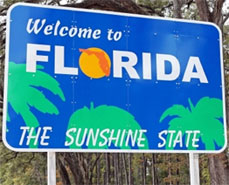We rarely hear about solar in Florida – the Sunshine State – or for that matter, efforts on energy efficiency, but that seems to be slowly changing.
Broward County – the second most populous in the state – voted unanimously to move forward with Property Assessed Clean Energy (PACE) financing, which will significantly boost demand for residential and commercial energy retrofits.
Financing is available for efficiency upgrades, such as HVAC and LED lighting, wind-resistance improvements and solar installations.

PACE makes these upgrades affordable because they can be paid off slowly through a small surcharge on property tax bills. Authorized in 27 states, upfront costs are spread out to match the payback period, so the annual cost savings exceed the tax assessments that come with property improvements like these.
"Contractors have been waiting a long time for this," says Larry Clark of Sustainable Performance Solutions, a Broward-based energy auditor. "We applaud the Commission for its leadership in unanimously moving Broward forward into a future full of good, green jobs."
Under the "open market" program, lenders will compete for customers rather than limiting participants to just one lender.
"This is a game-changer for the community," notes Michael Wallander of EcoCity Partners, the program’s administrator. "PACE provides a public good that should not be monopolized by one company, it should be used to create a competitive, open marketplace for innovative financing solutions."
EcoCity Partners administers the Florida Green Finance Authority, a partnership of local governments formed to offer PACE financing to commercial property owners. Among the programs is Florida Green Energy Works, which provides commercial financing.
The program could quickly lead to hundreds of millions of dollars of investment in energy saving upgrades. In another county, Renovate America approved over $300 million in residential PACE financing and funded nearly $100 million of energy retrofits in just one year.
With the addition of Broward County, Florida Green Energy Works expands to serve jurisdictions across 5 counties and over 2 million people. The company recently received $1.4 million in federal grants from the US Department of Energy and the US Economic Development Association to demonstrate a new streamlined financing process, provide free energy audits, and to help expand the program statewide.
Another interesting program in Florida is the SunSmart E-Shelter Program, which has installed about 100, 10 kilowatt solar PV systems at emergency shelters and schools across the state for back-up during hurricanes.
The program requires American-made components and received initial funding under the Recovery Act. It’s now funded by utilities.
Low electric prices and lack of political support have been holding Florida back on renewable energy. The state does not have a Renewable Portfolio Standard and doesn’t allow power purchase agreements, two key policies in other states that are driving solar installations. Gainesville, on the other hand, was the first US city to approve a feed-in law back in 2008.
Florida ranks #3 for solar resources, but #10 for solar capacity – it has a total of 202 megawatts (MW) installed, enough to power 20,000 homes, according to the Solar Energy Industries Association (SEIA).
The largest project is Martin Next Generation Solar Energy Center – at 75 MW, it powers over 11000 homes. Utility Florida Power & Light built the concentrating solar plant in 2010. In 2007, PACE started as a pilot program in Berkeley, California, and has since spread to 27 states and Washington, DC, where legislation is pending or in effect. PACE enjoys bipartisan support because it doesn’t rely on taxpayer funding, while creating jobs through greater energy efficiency and use of clean energy.
